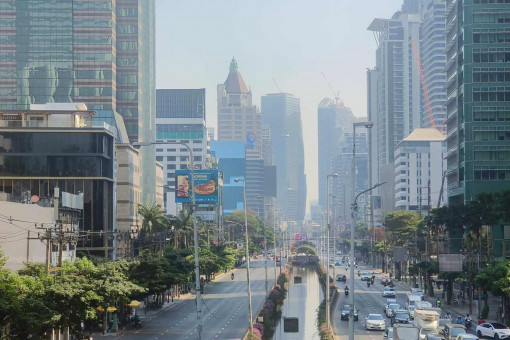
People in 55 of the 77 provinces were breathing dirty air on Wednesday morning, with red-coded pollution levels in 20 provinces, mainly in the Central Plains.
The Geo-Informatics and Space Technology Development Agency (Gistda) reported at 9am that unsafe levels of particulate matter 2.5 micrometres and less in diameter (PM2.5) ranged from 38.7 to 113.6 microgrammes per cubic metre of air over the previous 24 hours. The government-set safe threshold is 37.5µg/m³.
On Tuesday morning there was serious air pollution in 48 provinces, and the worst level was 145.2µg/m³.
On Wednesday, 20 provinces experienced red (seriously harmful) levels of fine dust pollution.
They were, in descending order, Ang Thong (the worst at 113.6µg/m³), Chai Nat, Singburi, Lop Buri, Samut Sakhon, Saraburi, Samut Songkhram, Nakhon Sawan, Ayutthaya, Pathum Thani, Uthai Thani, Suphan Buri, Nakhon Pathom, Nonthaburi, Nakhon Nayok, Bangkok, Ratchaburi, Kanchanaburi, Phichit and Samut Prakan.
Thirty-five provinces reported orange (starting to be harmful) levels of PM2.5.
They included Phetchaburi, Prachin Buri, Nakhon Ratchasima, Sukhothai, Chon Buri, Phitsanulok, Phetchabun, Chachoengsao, Kamphaeng Phet, Tak, Rayong, Prachuap Khiri Khan, Sa Kaeo, Chanthaburi and Uttaradit.
Others were Loei, Chaiyaphum, Trat, Khon Kaen, Nong Bua Lam Phu, Yala, Narathiwat, Pattani, Buri Ram, Phrae, Lamphun, Songkhla, Maha Sarakham, Nong Khai, Phatthalung, Lampang, Nan, Udon Thani, Surin and Phayao.
In Bangkok PM2.5 levels averaged 80.1µg/m³, with Don Muang district reporting the worst pollution at 181.2µg/m³, followed by Laksi (164.4µg/m³), Sai Mai (119.8), Bang Khen (108.3) and Nong Khaem (98.5).
Gistda reported that on Tuesday there were 310 fire hotspots in the country, mostly in farmland. Meanwhile, there were 1,516 hotspots in Cambodia, 270 in Myanmar, 228 in Vietnam and 181 in Laos.

